| |
| |
1997 RHD Maserati Ghibli Cup
A story of restoration / modernisation by a Ghibli Cup owner |
| |
As an owner of a Ghibli Cup, I thought it might be useful to document my experiences for other people considering purchasing one. I hope that the content of this article will be seen as an unbiased attempt to highlight the pros and cons of opting for one of the rarest and smallest engined of the RHD Maserati models. |
| |
Here is some of the technical data (as claimed by Maserati), although anyone considering buying a Cup should already be aware of this:
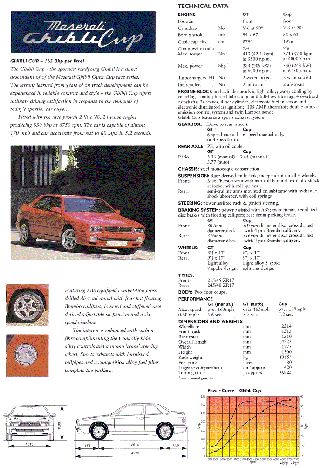
1996 cc V6 engine with four cams/pulleys (rear ones being chains).
Two separate ECUs (one per bank of three cylinders).
Two IHI roller-bearing turbochargers.
Two air-to-air cooled intercoolers.
Top speed: 167mph.
Maximum power (from engine): 330 bhp at 6,750 rpm.
Maximum torque: 275 lb ft at 4,000 rpm.
0 to 100 kmph (62 mph): 5.2 seconds (claimed to be 5.6 seconds by most of the UK motoring press).
Quarter mile: 14.4 seconds. |
| |
At the time of being sold in the UK (during 1997 and early 1998) it offered the highest power-per-litre of any production car (165 bhp per litre). In recent times this feat has been matched by the Lancer Evolution VIII FQ330.
You should consider that the Cup's claimed 330 bhp is not really accessible, since it is supposed to be achieved at 6,750 rpm - when the fuel cut-off occurs. Although this set-up allows for a top-speed of 167 mph (due to maximum power occurring at the top of the rev-range), it also means that in real terms the driver never actually has 330 bhp available to him. There is also a noticeable lack of torque (accelerator response) below 3,500 rpm, caused by the fact that the two turbos take some time to reach full boost.
These days the Ghibli Cup is somewhat overshadowed by the much cheaper (£32k) 2004 FQ330. The FQ330 has the same sized engine as the Cup (in fact, 1997 cc and has just 4 cylinders and a single turbo) but achieves an impressive 315 lb ft torque (albeit at a high 5,000 rpm). The FQ330's 330hp is achieved at 6,800 rpm (similar to the Cup). However, don't forget that back in 1997 when the Cup was sold in the UK, the top EVO models were producing less than 280 bhp. The standard equipment, such as leather seats, is similar for both cars, so the Ghibli Cup's £15,000 extra cost looks a little expensive, especially since the FQ330 also has satellite navigation.
Why the comparison to the more modern FQ330 you ask? Answer: Wait until the end of this document where the power statistics for my modernised Ghibli Cup will be supplied. All will become clear. |
|
 |
|
|
1. Background to my Ghibli Cup purchase
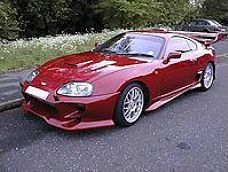
I used to own an UK Toyota Supra, with standard features including heated leather seats and 326 bhp twin sequential turbo-charged engine (hp peaking at an impressively low 5,800 rpm and max torque at 2,800 rpm). I then had its power output increased to just below 500 bhp, but retained a sequential system so that lots of torque was present before 2000 rpm. The car also had an aggressive Veilside body kit and several other extras to make it fairly unique.
When I sold it (to fund a house move) I lost a lot of money, so my next car needed to have at least a chance of retaining some of its value, but also needed to provide an exhilarating driving experience and seat my growing children. In preparation for my next purchase I compiled a short-list of cars for which I felt offered an acceptable balance between rarity, prestige and performance. None of the options would match the performance of a 500 bhp Supra, but I was prepared to settle for something less powerful that, like a Supra, could seat four people.
After hours of Internet searches, I compiled a shortlist covering a range of different performing cars. The following list is roughly in 0-60 mph performance order (fastest first, slowest last):
TVR Cerbera
Another UK 6-speed Toyota Supra
Audi RS4
Maserati Ghibli Cup
Maserati Ghibli 2.8GT
Audi S4
Maserati Quattroporte 3.2 Evolution
Mercedes 320 CLK
Initially, I gave most consideration to the top and bottom cars: The TVR for its looks, cool interior and performance and the 320 CLK for its practicality and low depreciation. However, one of the cars on the list had interested me due to its rarity and prestigious manufacturer - the Maserati Ghibli Cup. It had seemed unlikely that such a rare car (only 26 RHD built) would become available at a price I was willing to pay, so I had virtually disregarded it as "unrealistic".
After listening to the practical voice in my head I went as far as putting down a deposit on a Mercedes 320 CLK and was at home waiting for my cheque to clear when I noticed a Maserati Ghibli Cup advertised for sale on the Internet. It took a matter of seconds for me to decide to go and view it.
The Cup was being sold privately with a fairly high mileage, but the seller informed me that most of the mileage had been clocked up on the motorway and that the car had a full dealer service history (which the service log seemed to confirm). The car had very rusty exhaust tail pipes, some rust on the bodywork (primarily front and rear) and a cracked passenger-side headlight, but otherwise I was led to believe it was in good condition.
Being aware that someone else was interested in seeing the car and being mindful that my cheque for the Mercedes would soon clear, I made an offer that was accepted. As expected with a private sale, it was sold to me on an “as seen” basis. I had only had the opportunity for a visual inspection and a test drive on slow-moving residential roads. But, the choice was to make an offer or allow someone else to purchase it.
With almost 75,000 miles (recorded as 120,000 km) and an indicated full dealer service history, the £13,750 price that I paid had not seemed unreasonable for a RHD Ghibli Cup that was exactly six years old. I considered the price reasonable since the car had cost £47,500 new and at the time of my purchase a Maserati dealer had a low mileage 1997 Ghibli Cup on sale for £26,000. When I got home I cancelled the cheque for the Mercedes CLK and informed the garage that I did not wish to proceed with the purchase.
However, after taking ownership of the Ghibli Cup I found the following problems:
Tyres deflating by between 5psi and 15psi within a week (different tyres deflating at different rates).
Exhaust had more severe rust than I had originally thought, requiring a completely new twin exhaust system.
Windscreen wipers had a connection fault, requiring a replacement unit. I became aware of this problem when I was driving my car home in light rain.
Maserati stamped service history was incorrect. The major service that requires the engine taken out and chains replaced had, apparently, never been performed. Quite worrying, since I believed I was buying a car with a genuine full service history and the service log had been stamped at the regular intervals.
The climate control started playing up, only switching on after the car made a sharp right-hand turn!
Central locking was failing on passenger door, causing driver's door to immediately re-lock after using the remote button to unlock the car. Also, I could not rely on the doors locking properly and always had to check the doors were locked whenever parking the car.
Car put on rolling-road and found to be producing 220 rwhp (rear wheel horsepower) at 6200 rpm (instead of intended approximate 290 rwhp at 6750 rpm).
The private seller had failed to mention any of the above details to me, although he may genuinely have been unaware of some of them. |
|
 |
|
|
2. Owning a Cup
Here are a few comments (positive and negative) that I have received:
When having the exhaust system inspected, the technician told me that pre-1991 cars did not need cats, suggesting that I could save some money by not replacing them if I had a new exhaust system fitted. I had great trouble persuading him that my car was actually manufactured in 1997 and therefore required cats. He preferred to believe that I did not know the age of my car than to accept that the boxy rusty thing on his ramp was a modern car.
A close friend of mine regularly refers to my Ghibli Cup as "the shed". He states that it is the ugliest car that he has ever seen. This is the same guy who used to think my Supra was the best-looking car he had ever seen.
People's comparisons of my car have ranged from a Lancia Delta to a Lada. I've yet to hear someone make a flattering comparison. If you want a car with pulling power then look elsewhere!
My hairdresser saw me in the car at a petrol station just after I purchased it. When I next went to have my hair cut he was constantly talking about my car. He is a car enthusiast owning two modified Japanese imports and he once considered buying a Ghibli GT. He claims to like the appearance of the car.
When I went to have the car taxed at the post office then sad-looking man behind the counter sprung to life. He was asking what it was like to own a Maserati and seemed impressed that I owned one. However, he had no idea what the car looked like and would probably have been much less impressed if he had seen the car.
My young son keeps asking me to get another Supra but my daughter, who attends private school, likes to be able to tell her friends that she owns a Maserati. Even so, my daughter does not seem keen on her friends actually seeing the car! If I overtake enough cars then my son starts to become content.
Someone, whose friend has apparently had just paid £68,000 for a new Quattroporte, recognised my car instantly and claimed to prefer a Maserati to a Ferrari.
The fuel consumption around town is OK, although the Optimax fuel is more expensive than normal unleaded. However, if you drive the car as intended, with the revs quite high, then the fuel consumption becomes scary. At full boost you can almost see the fuel gauge decreasing as you drive.
The two-litre engine is unresponsive prior to the turbos providing boost. You can cruise on the open road at 2,000rpm or less, but don't expect any noticeable response from depressing the accelerator pedal when in the higher gears if the revs are below 2,500rpm. The car starts to feel sporty when the revs are above 3,500rpm and the turbos achieve full boost. At low revs those who compare the appearance of the car to a Lada might also be inclined to consider that it drives like a Lada too!
When driving the car at high revs (4,000rpm or higher) the car is great fun. It is just a shame that the Cup was not given the larger 2.8 litre engine so that it was more responsive at lower revs. Also, the fuel cut-off occurs at around 6,800rpm, so you do not have a massive rev-range in which to enjoy full boost. If you want an effortless drive then the Cup is not the car for you. To appreciate a Cup you must be prepared to use the gears to keep the turbos at full boost (and suffer poor fuel economy).
The interior is not bad, although the Momo steering wheel and carbon fibre panels do not offer the luxurious feel that you might reasonably expect from a Maserati. The interior is definitely unique, but apart from the hand-stitched leather, active suspension controls and the gold clock, there is not much to suggest that you are driving an expensive car. There is not even satellite navigation.
The Active Ride Suspension is one of the best features of the car. It always defaults to the second setting, which is reasonably soft and comfortable in most driving situations. I normally have it on the fourth setting, which makes the suspension very firm and is great for cornering. The first setting is for driving around town and provides the most comfortable drive, but not recommended if you wish to drive the car hard.
Basically, if you plan to buy a Cup then you should make that decision because you really want one. Don't expect it to impress your friends, family or neighbours. Don't expect high levels of luxury. Don't expect an effortless driving experience. Don't expect the two-litre engine to offer good fuel consumption unless you are prepared to drive it at low revs. The Cup can be a great drive and provides good road holding and excellent braking, but there are much cheaper and sexier car options available if you just want a four-seat performance car. Wanting something that is different and pretty unique (whilst not minding much higher than average maintenance costs) needs to be a deciding factor when considering a Ghibli Cup. You buy this car to join a unique group of owners/enthusiasts - not to own a remarkable sports car. |
|
 |
|
|
3. My expenditure / restoration costs
This is what I ended up having done to the car (some proved better value for money than others):
Wheels refurbished with central spoked section painted blue to match body colour and bolts all zinc coated. Wheels refurbished and resealed to stop leaks for a total cost of GB £517.00.
Ordered a replacement RHD headlight but discovered, after fitting, that I had been supplied one for an LHD car, which was illegal on UK roads. A second headlight was ordered and fitted.
New stainless steel exhaust system manufactured for the car with 1/8in increase in diameter, two free-flowing performance cats and two larger oval tail pipes. Total cost, including fitting was an incredibly low GB £850.00.
Full service performed, including fixing climate control, door locking, ABS work and replacing many worn brake cables. This included removing the engine and replacing the chains. Some boost issues were also identified and fixed, for a total cost exceeding GB £5,000.00. The passenger locking mechanism was re-greased, and has only so far failed to work correctly twice since the service. I will not be surprised if the locking and climate issues return again in the future.
The car was taken to a body shop to repair most severe rust at front and side of car for a cost of around £450.00. Some rust remained at the rear of the car, but not too noticeable. Unfortunately, it did not take long for the rust at the front of the bonnet to start to return. I booked the car in at another body shop just six months after the original work was done, and this time spent £500.00 addressing all reappearing and outstanding rust spots and scratches.
Ultra light carbon fibre rear wing acquired, painted and fitted to the car. This wing is so light that the weight of the boot has not noticeably increased. Total cost including painting and fitting was £300. I have had several Maserati fans accuse me of ruining the car, and I can understand their anger. However, for those who saw the car as a "shed on wheels", the rear-wing has provided the car with a sportier look and gained more respect. Maybe I have responded to the views of the less sophisticated members of society, and risked upsetting people who posses good taste, but if I ever chose to remove the wing and restore the car to its original appearance, it could be easily done. Also, the rear wing does aid in rear-wheel traction, thus enhancing the good road holding of the Ghibli Cup.
Trident central wheel logos commissioned with sign-making company. The original ones were damaged and replacements are no longer available for purchase. The blue 'Speedline' logos that can be purchased as an alternative are, in my opinion, ugly and I felt they would ruin the appearance of the wheels. Cost £120.00 for four central wheel logos and two side wing logos. I also have short steel valves and locking 'Maserati' logo valve caps to optimise the appearance of the wheels.
[Motec M600 Engine Management System to be professionally fitted: Details of power/torque increases to be given once this work has been performed]. |
|
 |
|
|
4. After Refurbishment
The car has improved considerably from the rust bucket I had purchased six months earlier.
These are some of the features of the Ghibli Cup:
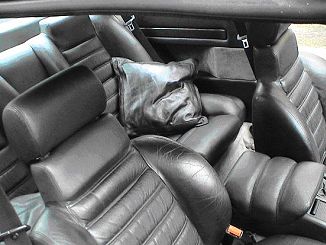 High quality hand-stitched black leather interior with seats that feel like they belong in your living room. Apart from electronic back of seat angle adjustment, the seats are fairly basic (no heating, no memory, no lumber adjustment, pull-bar for moving seats forward and back). High quality hand-stitched black leather interior with seats that feel like they belong in your living room. Apart from electronic back of seat angle adjustment, the seats are fairly basic (no heating, no memory, no lumber adjustment, pull-bar for moving seats forward and back).
I added the leather cushions, since I thought they provided an extra feel of luxury. Just about enough rear legroom for adult passengers.
Central rear leather armrest can be pulled down to separate squabbling kids!
Carbon fibre and black leather interior, with standard gold clock.
Momo leather steering wheel and Momo carbon fibre/chrome gear stick.
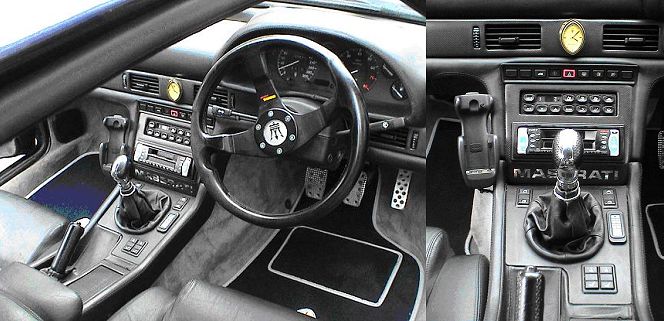
But why no wood in a £47,500 car?
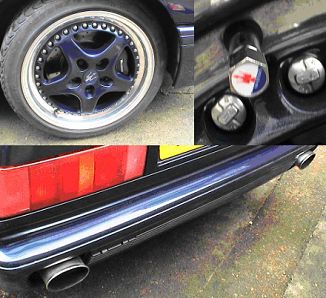 Refurbished lightweight Speedline 17" sectional wheels.
Central sections painted same colour as car body.
Middle of the wheels display chrome Maserati trident logo on blue background.
Even the lockable valve caps have the Maserati name and trident logo.
The entire twin exhaust system was replaced with a professionally designed stainless system.
The tail pipes are a little larger than the one fitted to the Cup as standard.
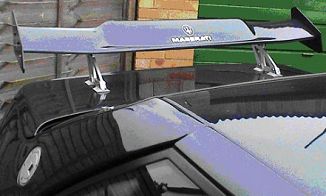
The rear-wing is body-coloured with chrome legs and weighs only 4lbs. The chrome legs match the chrome petrol cap.
It is angled to increase down-pressure on the rear wheels and aid with traction.
It has trident logos on each side and a trident logo and the text 'Maserati' on the top, which are visible in the rear-view mirror when driving.
 All Ghibli Cups have the Ghibli Cup logo on either side in front of the doors. Please excuse the loss of background colour, but the is a photo of a logo from my car. All Ghibli Cups have the Ghibli Cup logo on either side in front of the doors. Please excuse the loss of background colour, but the is a photo of a logo from my car.
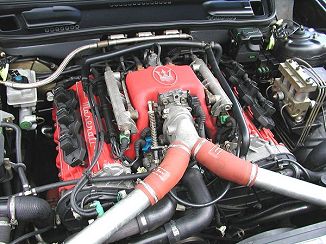
The standard engine is the all alloy 1996 cc V6 @ 90° unit with:
82 mm bore X 63 mm stroke
Compression ratio 7,6
4 overhead camshafts
Four valves per cylinder 2 IHI roller-bearing water-cooled turbochargers
2 air-to-air intercoolers
Electronic fuel injection and direct ignition with two separate ECUs. |
|
 |
|
|
5. The Motec M600 ECU
Even after the expensive service, the car was still only making 240 rwhp (20 more than before). However, the power curve was now much more impressive, reaching 240 rwhp (270 at flywheel**) at a more acceptable 5500 rpm, which was 700 rpm less than the power had previously been peaking. The car seemed to be overboosting and thus loosing power in the high rev-range. Had the boost continued to rise until 6750 rpm then the car may well have been achieving intended power levels.
The car was taken to a performance tuning company who specialises in race-tuning turbo cars. They gave the car an inspection and could not see any mechanical reason for the boost problem. It was felt likely that ECU problems, possibly worsened by the new free-flowing exhaust system, were causing the boost to be cut-off early.
As a result, I decided to add a Motec M600 engine management system to the car (to replace the two existing ECUs) with the hope of exceeding the original power levels of the car. On normal turbo cars a Motec system usually provides a power increase of at least 25%. Considering the existing boost problems and the new performance exhaust system, I was hoping the current 240 rwhp could potentially increase by more than 25% after fitment of the new ECU. However, I wanted to achieve maximum power at lower revs, which I felt could limit the maximum achievable power output.
** NOTE: Different companies tend to calculate flywheel horsepower differently, partly due to the fact that rolling roads are actually measuring torque and horsepower is derived. The only way to get true horsepower readings would be to remove the engine from the car!
The race-tuning company that dyno'd my car after its £5,000.00 service considered 240 rwhp to equate to 260 flywheel horsepower (8.3%). Maybe this fairly low bhp calculation was due to their experience of race-tuned cars, which would commonly have lightweight flywheels. I'm guessing that the flywheel in a Ghibli Cup is fairly heavy, although I have nothing to base that assumption on.
Another garage's rolling road inspection, performed immediately after I purchased the car, had suggested that the then recorded 220 rwhp equated to 268 flywheel horsepower (22%). Other (so-called) experts suggest 15% difference for rear-wheel drive cars.
Considering this discrepancy, I feel that a reasonably conservative 12.5% calculation should be used to calculate flywheel horsepower for my car. Therefore, based on 240 rwhp my car would have been peaking at 270 bhp at 5,500rpm.
Not everyone will agree with my 12.5% calculation, but at least you now understand the basis for my decision, considering that calculating flywheel horsepower does not seem to be an exact science. It is probably also worth giving some consideration to the fact that 270 bhp @ 5500 rpm would equate to 330 bhp @ 6750 rpm if a straight-line power gradient existed, which in reality is not the case.
The only two things that really matter to me are torque and rear-wheel horsepower (at the lowest possible rpm). A horsepower figure measured at the flywheel (such as 330 bhp @ 6750 rpm) means nothing when you are driving the car. What really matters is how well the car responds when you depress the accelerator pedal. |
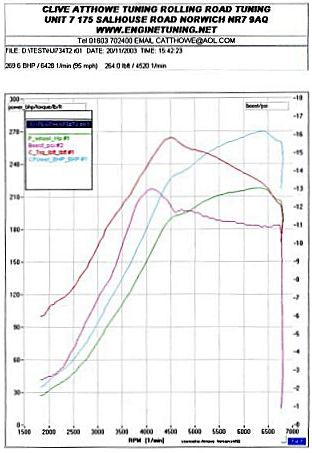
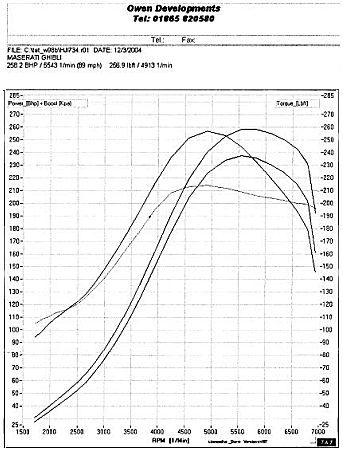



 High quality hand-stitched black leather interior with seats that feel like they belong in your living room. Apart from electronic back of seat angle adjustment, the seats are fairly basic (no heating, no memory, no lumber adjustment, pull-bar for moving seats forward and back).
High quality hand-stitched black leather interior with seats that feel like they belong in your living room. Apart from electronic back of seat angle adjustment, the seats are fairly basic (no heating, no memory, no lumber adjustment, pull-bar for moving seats forward and back).


 All Ghibli Cups have the Ghibli Cup logo on either side in front of the doors. Please excuse the loss of background colour, but the is a photo of a logo from my car.
All Ghibli Cups have the Ghibli Cup logo on either side in front of the doors. Please excuse the loss of background colour, but the is a photo of a logo from my car.